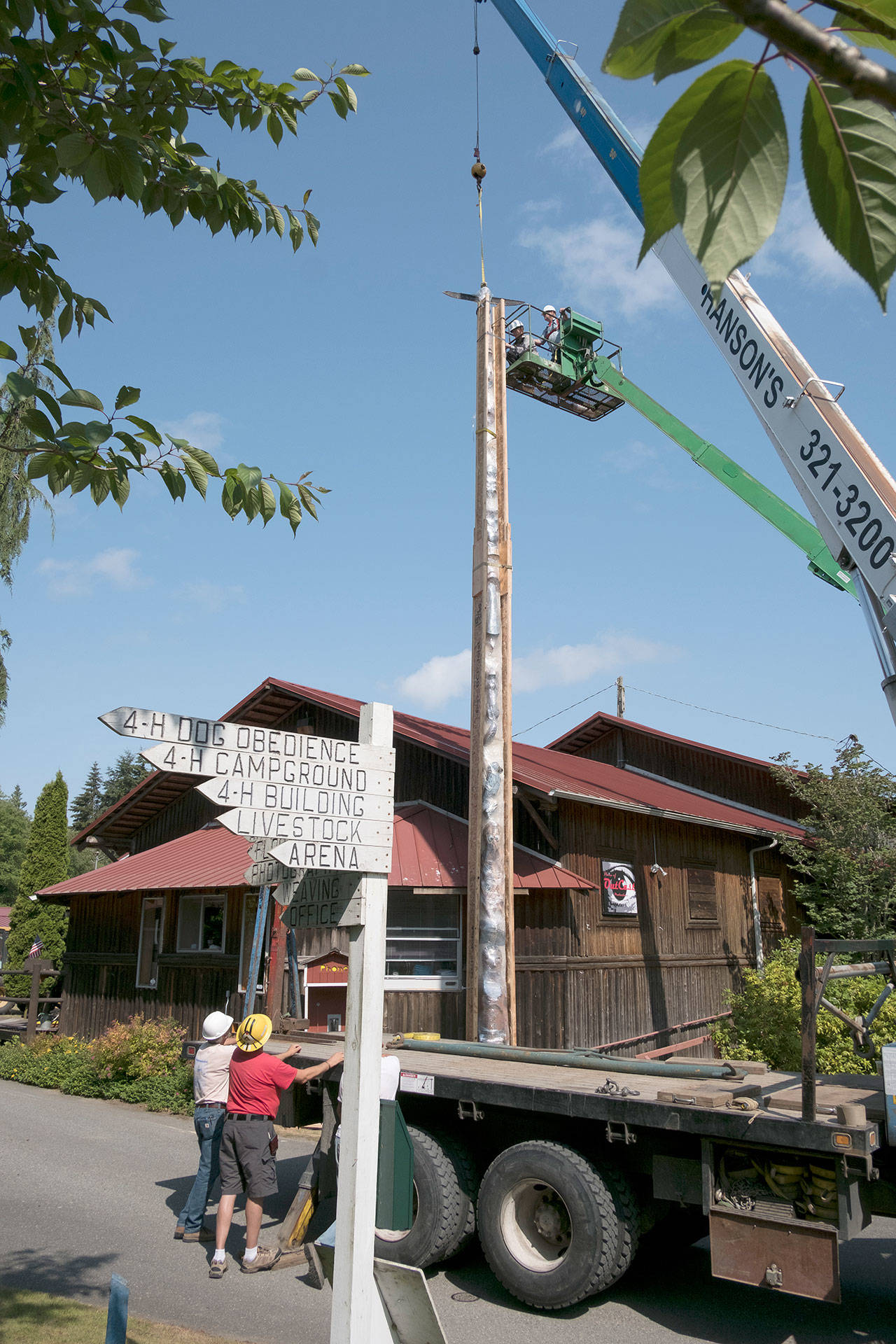If only the story pole could talk.
Fifty feet tall, it peered down on generations of families who made the annual summertime trip to the Island County Fairgrounds to see the 4-H exhibits, eat curly fries by the cart load and scream in delight on carnival rides.
Crafted from Western red cedar, the story pole was taken down last month by the Port of South Whidbey for safety reasons and for restoration assessment.
It’s now wrapped up and resting in an unfamiliar horizontal position between the Burrier and Turner buildings.
After more than 70 years of being exposed to the elements, its base is rotted and damaged.
“It is our intention to have the Tulalip Tribes restore the story pole,” said Angi Mozer, outgoing port executive director, “but we will need to pay for the restoration.”
The port now owns and maintains the fairgrounds.
William Shelton, a well-known carver with the Snohomish Tribe who was raised on Whidbey Island, was believed to be the artist of the fairgrounds pole.
It’s created in the style of other story poles he carved starting in 1912 until his death in 1938.
One of his story poles stood for 70 years on the capital grounds in Olympia before deterioration forced its removal.
The Burke Museum at the University of Washington also has a Shelton story pole that stood for decades in an Illinois town park that it hopes to restore.
A story pole differs from a totem pole, in that a totem pole tells a tribal or family story while a story pole illustrates and passes down Native American legends and folktales.
Last summer, curators and carvers with the Tulalip Tribes examined the fairgrounds pole and identified it as a Shelton pole. But the story pole’s story took a dramatic turn in February when South Whidbey historian Bill Haroldson heard an alternative version of its origin.
“Jim Brevig said his uncle, Paul Cunningham, carved the pole and he had this older Native American telling him what to carve, what order to carve in and exactly what paint to use,” said Haroldson, president of the South Whidbey Historical Society.
According to Brevig, now 87, two poles were carved on the family’s Bayview property, but he’s unsure of the exact year. Other relatives also recall the scene of a native man passing along his skills to Paul Cunningham, who was Caucasian.
“There were two tall totem poles and two short ones in my grandfather’s yard,” said Albert Hagglund, 83. “There was an Indian showing him how to carve it.”
Cunningham is the maiden name of Hagglund’s mother.
Tessa Campbell, curator with the Tulalip Tribes, said she’s been unable to locate any historic photos or documentation proving William Shelton carved the pole. She has, however, found a connection between Shelton and Cunningham.
“We have located archival materials in our collection that depict that Shelton and Cunningham were good friends,” she said. “We have photos of Cunningham and newspaper articles about them giving public presentations together.”
Shelton became an advocate for Native American rights during the era of forced assimilation by the federal government. He acted as a bridge between the two worlds. He and his daughter would demonstrate native dancing, singing, drumming and storytelling at civic events around Puget Sound.
Shelton dressed in a Great Plains-style native costume with full headdress, even though that wasn’t the style of coastal tribes. When asked about it, he reportedly would answer, “If we are going to fight for American Indians, we need to look like Indians. The only Indians white people see are in the movies, and we need to look like them.”
The fairgrounds pole could be what’s known as a teaching pole. Like other Shelton poles, figures are carved in high relief, giving them a three-dimensional look.
An eagle rests on top with wings spread and a native man with a single feather headdress anchors the base. In between are a rock, an octopus holding a salmon, a bird, a bushy-tailed fox, a whale, a mouse standing on a pedestal, a spider, a six-rayed sea star and two faces.
Who carved the fairgrounds pole, what story is being told by its carvings, how it ended up on the fairgrounds and what year it was erected there remain mysteries, Haroldson said.
Consulting longtime Whidbey families, such as the Gabeleins, Skarbergs and Hagglunds, was part of Haroldson’s detective work.
“I’ve been a little unnerved by this,” he admitted. “Up until February, we had a pretty straightforward story. Now the only definitive answer we have is, ‘We don’t know.’”
If its history remains a mystery, plans to refurbish it may be altered, Haroldson said. Many questions remain.
Was it on loan to the fairgrounds by the Cunningham family? Was there a signed agreement that’s since disappeared? And if the pole isn’t indigenous art, is it still worth preserving?
To the last question, Haroldson offers a resounding, “Yes.”
“We do feel it is an artifact of William Shelton and of Whidbey Island,” he said. “It was carved in the Shelton Tradition.
“The fairgrounds pole remains as a legacy of William Shelton and his efforts to bridge the gap between Native America and White America.”
• If you have information or historical photos of the Fairgrounds story pole, contact Bill Haroldson at wharolds@whidbey.com


